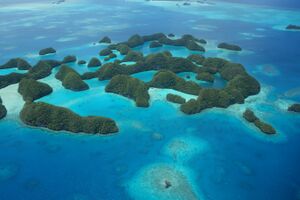Biology:Rock Islands
| Nickname: Chelbacheb | |
|---|---|
 Aerial view of Ngerukewid | |
| Geography | |
| Coordinates | [ ⚑ ] : 7°14′N 134°18′E / 7.233°N 134.3°E |
| Total islands | 250-300 |
| Area | 41.12 km2 (15.88 sq mi) |
| Highest elevation | 207 m (679 ft) |
| Administration | |
Palau | |
| Demographics | |
| Population | 6 (2014) |
| Official name | Rock Islands Southern Lagoon |
| Criteria | Cultural: iii, v; Natural: vii, ix, x |
| Reference | 1386 |
| Inscription | 2012 (36th session) |
| Area | 100,200 ha |
| Buffer zone | 164,000 ha |
The Rock Islands of Palau, also called Chelbacheb, are a small collection of limestone or coral uprises, ancient relics of coral reefs that violently [citation needed] surfaced to form Islands in Palau's Southern Lagoon, between Koror and Peleliu, and are now an incorporated part of Koror State. There are between 250 and 300 islands in the group according to different sources, with an aggregate area of 42 square kilometres (16 sq mi) and a height up to 207 metres (679 ft). They are a World Heritage Site since 2012.
The islands are sparsely populated and are famous for their beaches, blue lagoons and the peculiar umbrella-like shapes of many of the islands themselves. The Rock Islands and the surrounding reefs make up Palau's popular tourist sites such as Blue Corner, Blue Holes, German Channel, Ngermeaus Island and the famed Jellyfish Lake, one of the many Marine lakes in the Rock Islands that provides home and safety for several kinds of stingless jellyfish found only in Palau. It is the most popular dive destination in Palau, and offers some of the best and most diverse dive sites on the planet. From wall diving to high current drift dives, from Manta Rays to sharkfeeds an from shallow and colorful lagoons to brilliantly decorated caves and overhangs. The islands are the location of Dolphin Bay - where there is a staff of vets and trainers that educate about the life of dolphins.
Many of the islands' display a mushroom-like shape with a smaller base at the intertidal notch than what lies above it. The indentation comes from erosion and from the dense community of sponges, bivalves, chitons, snails, urchins and others that graze mostly on algae.[1]
The largest islands in the group are:
- Ngeruktabel
- Ulong
- Eil Malk (Mecherchar)
Other notable islands include:
- Ngeteklou (Gologugeul)
- Bukrrairong (Kamori)
- Tlutkaraguis (Adorius)
- Ongael
- Ngebedangel (Ngobasangel)
- Bablomekang (Abappaomogan)
- Ngerukewid (Orukuizu)
- Ngeanges
Demographics
The only inhabited place on the islands is called Dolphin Bay (on Ngeruktabel, 5 km from Koror). It is the location of Palau's national aquatics park, and hosts headquarters of Palau's Park rangers.
Gallery
See also
- Desert island
- List of islands
Notes
- ↑ Murphy, Richard C. (2002). Coral Reefs: Cities Under The Seas. The Darwin Press, Inc.. pp. 60–61. ISBN 0-87850-138-X.
External links
 |























